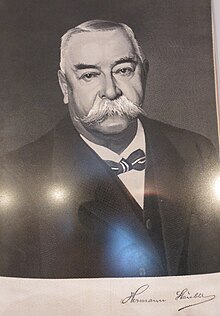Hermann Stäubli
Hermann Stäubli (born March 8, 1867 in Horgen ; † October 1940 there ) was a Swiss entrepreneur .
life and work
Hermann Stäubli grew up as the son of a card maker and a silk weaver in Horgen. He attended primary school in Käpfnach and secondary school in Horgen. After finishing school he learned card maker in the machine factory Schelling & Co., Stotzweid in Horgen, where his father was a master craftsman. When he was 18, his employer sent him to Italy and Germany for further training.
After his return he began an apprenticeship as a mechanic at Schelling & Co. After successfully completing his apprenticeship, he went on a journey to western Switzerland, where he learned about precision work from watchmakers. At the age of 22 he became a master craftsman at his training company, which among other things manufactured the English Hattersley dobby. He fundamentally improved the mechanism of this machine and had his invention patented in 1892.
In 1892 he founded the company Schelling & Stäubli (today Stäubli International ) with Rudolf Schelling and, from 1893, manufactured his new dobby machines (rattiers) in rented rooms with two workers and an apprentice. The new company received its first order from the Horgner silk weaving mill Schenkel & Staub. The dobby machines sold well, and after 1895 (expanded in 1899 and 1937) he was able to build a new factory at the current location (Stäubli Areal West) Rotweg / Seestrasse and employ 32 workers from 1896. In 1900, the in-house design was further developed into the first paper card dobby, equipped with the reading system that is still widely used today.
Around 1900 he opened branches in Sandau , Austria, and Faverges , France, in addition to the head office in Horgen , and at times employed up to 400 workers. After Rudolph Schelling's death, his brother Robert Stäubli became a partner, and the company was renamed Gebrüder Stäubli in 1909. Villa Bellavista was built in 1907 on the edge of the slope above the factories and the tenant house. In 1915, the first counter-pull dobby machine for sample cards was made from wood.
With the First World War , sales collapsed and Stäubli had to sell the factory in Austria in 1916. As he did not want to produce ammunition out of religious convictions, but also did not want to lay off his workers, he began building smaller machine tools.
After his brother Robert's death in 1925, he took his sons Hermann (1895–1943) and Robert, who ran the company in Faverges, and son Hugo (1899–1969), technical manager of the parent company in Horgen, into the company. About ten years later, the youngest son Othmar (1907–1985) joined the company.
In 1937 the factory in France burned down. In the same year the first two-cylinder paper card dobby machine for the production of matched fabrics and the first name weaving machine were built.
A large number of domestic and foreign patents testify to Hermann Stäubli's inventive activity.
literature
- Gerhard Spinner: In memory: Farewell words at the funeral of Hermann Stäubli 1867–1940, Friday, October 4, 1940 in the church in Horgen. Steno-Verlag, 1940.
- J. Lukas: Hermann Stäublis life and work. In: Communications about the textile industry. Swiss specialist publication for the entire textile industry. Volume 47, 1940, issue 11 doi : 10.5169 / seals-627623 .
- Paul Kläui: History of the community of Horgen. Horgen 1952, pages 517-522.
- Ad. Bürkli-Meyer: History of the Zurich silk industry from the end of the XIII. Century to modern times. In: Neue Zürcher Zeitung . Year 1888, No. 364, second sheet, pages 214–216.
- R. Honold: 50 years of Stäubli dobby machines 1892–1942. In: Communications about the textile industry. Swiss specialist publication for the entire textile industry. Volume 49, 1942, Issue 7 doi : 10.5169 / seals-627409 .
Web links
Individual evidence
- ↑ 125 years of Stäubli. From mechanics to mechatronics. In: Digital Manufacturing. 28th July 2017.
- ↑ J. Lukas: Hermann Stäubli's life and work. In: Communications about the textile industry. Swiss specialist publication for the entire textile industry. Volume 47, 1940, Issue 11
| personal data | |
|---|---|
| SURNAME | Stäubli, Hermann |
| BRIEF DESCRIPTION | Swiss entrepreneur |
| DATE OF BIRTH | March 8, 1867 |
| PLACE OF BIRTH | Horgen |
| DATE OF DEATH | October 1940 |
| Place of death | Horgen |

